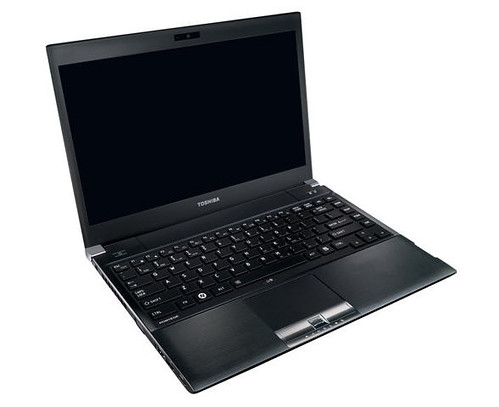Toshiba Portégé R830

Toshiba's Portégé R series has been popular among those wanting thin and light notebooks for a while, although as we noted when we looked at a predecessor, the Portégé R700 you need to pay out a pretty penny if you want the very best features available.
The design of the new Portégé R830 owes everything to the R700. The chassis is — as far as we can tell — identical, and the upgrades and alterations are all on the inside.
An all-black magnesium alloy shell houses a 13.3in. screen with a native resolution of 1,366 by 768 pixels, and measures 31.6cm wide by 22.7cm deep by 1.83-2.66cm thick. It weighs 1.48kg including an optical drive: compared to the new ultraslim Portégé Z830 ultrabook, which weighs 1.2kg and lacks an optical drive, the weight seems reasonable.

Toshiba offers many different versions of this notebook — there are eleven on the company's web site at the time of writing. The one I was sent, the Portégé R830-1DX, retails for £1,049 (ex. VAT) and has an Intel Core i3-2330M processor with 4GB of RAM and a 500GB hard drive spinning at 7,200rpm. At the top end you'll pay £1,599 (ex. VAT) for a Core i7-2640M with 8GB of RAM and a 128GB SSD. The entry-level model costs £949 (ex. VAT). Some iterations lack an optical drive.
Whatever model you choose, there's a spill-resistant isolation-style keyboard whose keys don't deliver much return, and which will probably best suit typists with a light touch.
Ports and connectors include a USB 3.0 port, a USB 2.0 port and an eSATA/USB combo port, HDMI and VGA ports, an Ethernet connector and an SD card slot. The battery is rated as good for up to 8 hours and 55 minutes.

Toshiba could probably have shaved a few millimetres off the R700's chassis. It might even have boosted the screen resolution. However, there's no doubting that the existing design works well.
This ultraportable format is going to take a battering from upcoming 'ultrabooks' — not least from Toshiba's own business-oriented Portégé Z830. The level of demand for integrated optical drives and access to the battery might be the deciding factor in the fate of the Toshiba Portégé R830.
Sandra Vogel